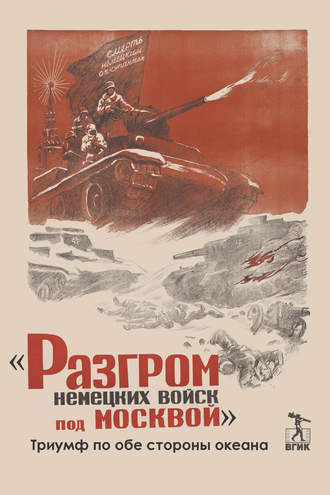
Коллектив авторов
«Разгром немецких войск под Москвой». Триумф по обе стороны океана
К 75-летию первого «Оскара» советскому фильму
Всероссийский государственный институт кинематографии имени С.А. Герасимова
При поддержке Министерства культуры Российской Федерации
Авторский коллектив:
Изволов Н.А., кандидат искусствоведения,
Каптерев С.К., доктор философии (PhD),
Караваев Д.Л., кандидат искусствоведения,
Малышев В.С., доктор искусствоведения,
Николаева-Чинарова А.П., доктор философских наук,
Прожико Г.С., доктор искусствоведения,
Русинова Е.А., кандидат искусствоведения.
Defeat of the German Forces Near Moscow, a documentary feature directed by Leonid Varlamov and Ilya Kopalin in 1942, is a dramatic record of the beginning of the end of Hitler’s war machine. Under the guidance of the two experienced filmmakers, a crew of battlefield cinematographers (around 15 people, many of them graduates of the All-Union) documented die counter-offensive of the Red Army and preparations for this brilliant military campaign which lasted between December 1941 and January 1942 and became the first major victory over the Wehrmacht.
Initially planned as a short, Defeat included footage shot at the front line and on the home front especially for this project, as well as materials taken from Soviet war newsreels and some staged sequences enhancing the film’s overall impact. It demonstrated the growth of the Red Army’s might after its retreat at the early stages of the German invasion and also recorded the terrible results of the Nazi occupation of the Soviet land in a series truly striking images aimed to show the barbaric nature of Nazism to Soviet and foreign audiences.
Besides being a brilliant example of effective wartime propaganda, laconic and, at the same time, grandiose, Defeat of the German Forces Near Moscow was a major contribution to the development of documentary filmmaking. It showed a large-scale military campaign as a complex but efficient combination of efforts undertaken on all levels of the military establishment and in all segments of society; and, for the purposes of emotional effect, it did not avoid the display of wartime atrocities – a method which was predominantly censored in other film cultures. It also enhanced its presentation of the Soviet vision of the war by emotional film editing, a touching patriotic score and a set of historical and cultural allusions which, among other things, were to help the foreign public empathize with die patriotism of the peoples of the Soviet Union and understand their crucial role in the rout of I li tier’s armies.


